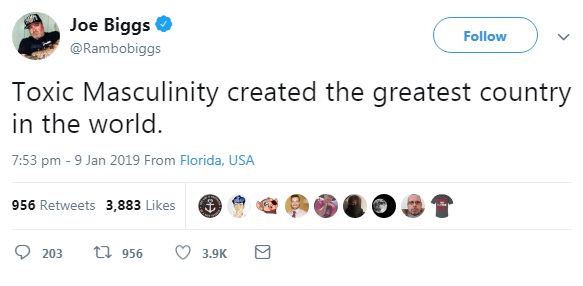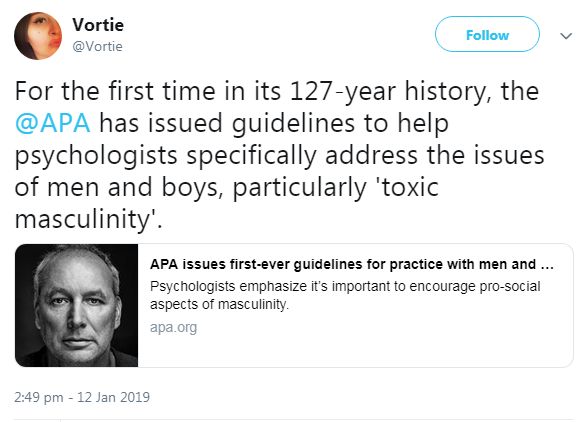Remember those age-old male traits from a more chivalric, less neurotic epoch, like ruggedness, stoicism, individualism and masculinity? Well, you can chuck them into the dumpster outside your local gender studies classroom because they have just been branded harmful to your health.
Although ‘masculinity’ once upon a time helped ‘privileged males’ tame the American wilderness, build cities and exhibit courage in battle – among other dirty tasks that required no small amount of brute strength and even aggressiveness – the medical community would now have us believe there is something inherently wrong with masculinity.
In the American Psychological Association’s ‘Guidelines for Psychological Practice with Boys and Men’, traditional notions of masculinity are described as undesirable for a host of reasons, but perhaps most disturbingly because “boys and men who identify as gay, bisexual or transgender still face higher-than-average levels of hostility and pressure to conform to masculine norms.” In other words, the so-called ‘toxic masculinity’ that has helped men and civilization progress over the centuries has been written off as “harmful” because some males – either by choice or otherwise – feel threatened by it.
Pseudo-science pounces right out of the gates of the study as we are introduced to yet another parallel reality known as the “masculinities.” No longer does the singular adjective ‘masculine’ suffice these days of multiple genders and diverse lifestyles because apparently that would offend a minority subculture of those males whose notions of masculinity do not flush with those of the majority.
In the opening paragraph we are informed that “It is common to use the term ‘masculinities’ rather than ‘masculinity’ to acknowledge the various conceptions of masculine gender roles associated with an intersection of multiple identities.” The medical community's habit of tossing about scientifically unproven claims of “multiple identities” brings to mind Ken Kesey’s ‘One Flew Over the Cuckoo’s Nest’ where the medical staff, the ones with the real issues, pushes pure quackery on a trapped patient population.
The guideline continues with something of a caveat: “When trying to understand the complex role of masculinity in the lives of diverse boys and men, it is critical to acknowledge that gender is a non-binary construct [in other words, comprised of more than just males and females] that is distinct from, although interrelated to, sexual orientation.”
Here, the authors insist (“critical to acknowledge”) that society as a whole must cater to the whims of that tiny segment of the population that believes it may not only choose the gender they identify with as if they were shopping in a Fifth Avenue boutique, but that the rest of society must use the ‘correct pronouns’ when addressing them. Yet, the overwhelming majority of males who are comfortable with their biologically assigned sex and gender, as well as their masculinity, are now being told something is inherently wrong with them. This is openly admitted.
And I quote: “The main thrust of the subsequent research is that traditional masculinity—marked by stoicism, competitiveness, dominance and aggression—is, on the whole, harmful. Men socialized in this way are less likely to engage in healthy behaviors,” writes Stephanie Pappas in a summary.
Proof of this assertion is provided by various questionable studies, including one by James Mahalik, PhD, of Boston College, who found that the more men "conformed" to masculine norms, the more likely they were to consider as normal risky behavior such as heavy drinking bouts, abusing tobacco and – wait for it – not eating their vegetables.
However, a weekend trip to a nightclub would quickly prove that a high percentage of females – with not a trace of masculinity in their bodies – also engage in those same risky activities. Yet with a wave of the academic wand, centuries of male accomplishments have been flushed down the proverbial toilet because part of the male population has a tendency to drink alcohol, smoke cigarettes and push veggies to the side of their plates. In any case, the Psychological guideline conspicuously fails to mention any of the tremendous accomplishments of the male species and the necessary amount of masculinity that has made modern urban living a comfortable reality in the first place. That is an unforgivable omission.
All of this hand-wringing over 'toxic masculinity' will only set up the male population for more dangerous ‘preventive measures’ now seen today, where many schools, for example, no longer provide recess period to their students, who are bursting with youthful energy and excitement. Instead, the medical community would rather brand boys who can’t sit still at their desks with ‘Attention-Deficit Disorder’ and medicate them into a somnambulist state of submissiveness and passivity.
Below is a video of a young woman who discusses her “horrible” experience with a university gender studies course for anyone who wants a nice primer on the subject.
Further on we learn that in Western culture, the dominant ideal of masculinity is of “a more rugged and self-sufficient ideal.” This is not a good thing because, according to the almighty guidelines, such attributes may infringe upon that infinitesimal segment of the male population “who depart from this narrow masculine conception by any dimension of diversity (e.g., race, sexual orientation, gender identity, and gender expression)” and thus may find themselves “negotiating between adopting dominant ideals that exclude them or being stereotyped or marginalized.”
In other words, otherwise normal males exhibiting symptoms of masculinity, much as men have throughout the life of the species, are the ones with the problem. Why? Because a small fraction of the males do not subscribe to the “narrow” definition of masculinity (“rugged and self-sufficient”), which the APA itself has drawn up.
So instead of drawing up special guidelines on how the Psychological community should handle that tiny fraction of the population who feel uncomfortable with displays of “traditional masculinity,” the good doctors have taken it upon themselves to treat the entire male population as if it were one big patient in desperate need of counseling – and possibly even medicating, which should make the pharmaceutical industry very happy indeed.
In reality, the ones who are in need of serious guidelines are these so-called medical professionals – in cahoots with the media industry and drug makers – who continue to push this insidious and hyper-liberal Cultural Marxist value system upon an unwitting population.











